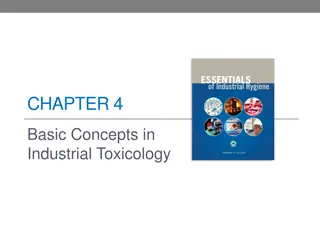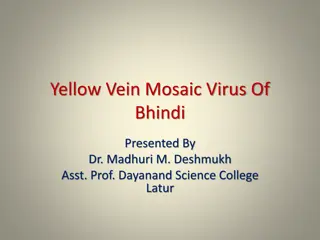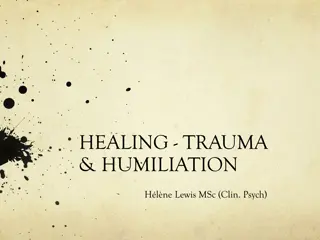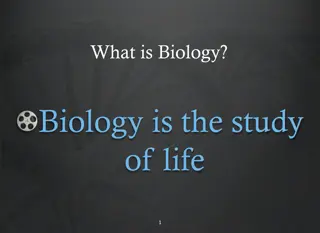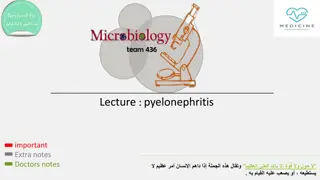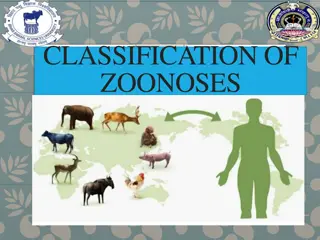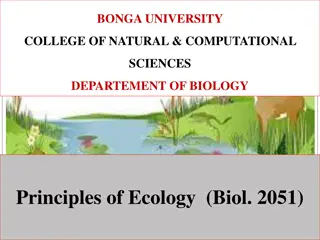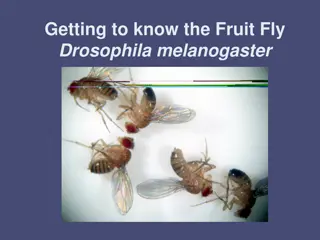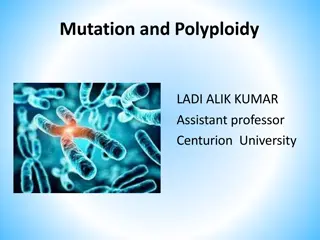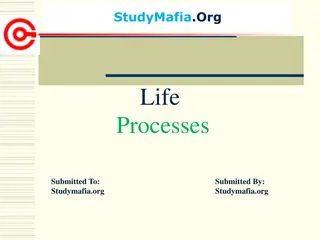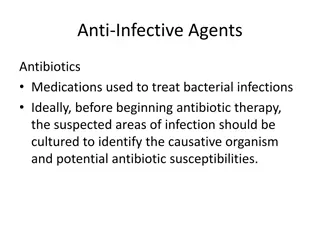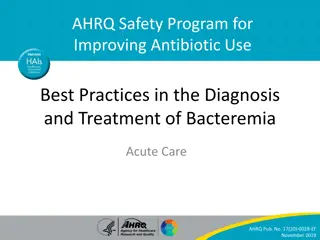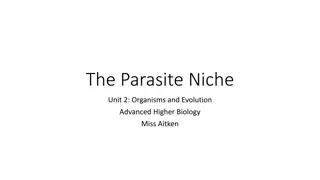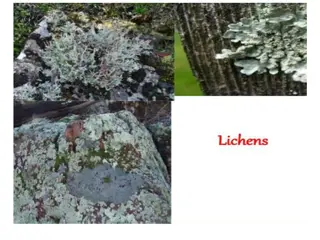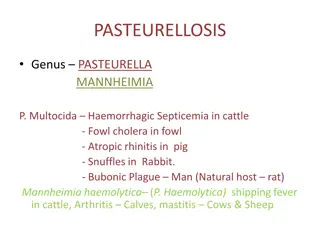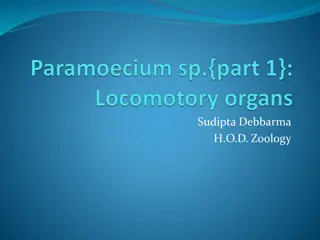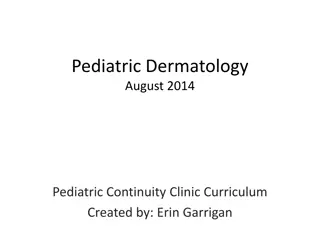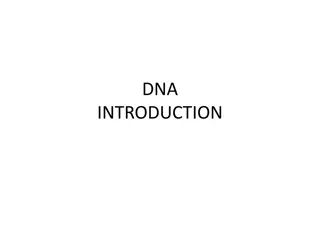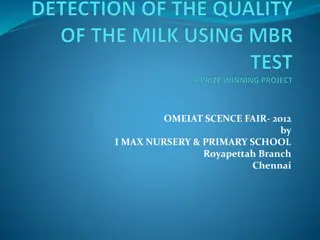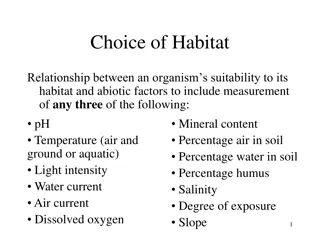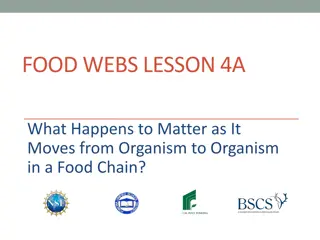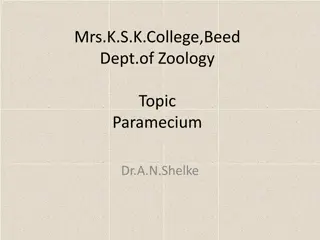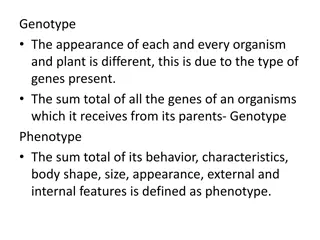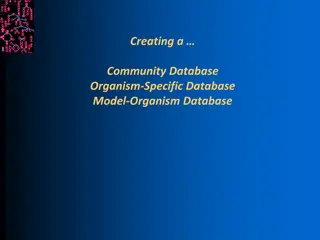Understanding the Fate of Herbicides in Soil
The fate of herbicides in soil is influenced by factors such as micro-organism decomposition, chemical decomposition, photodecomposition, adsorption by soil, surface runoff, leaching, plant uptake, and volatilization. Micro-organisms like algae, fungi, actinomyces, and bacteria play a crucial role i
6 views • 7 slides
Understanding Species Interactions and Predator-Prey Dynamics
Species interactions refer to the associations between different organisms that can be positive or negative, influencing the growth and evolution of populations. Predation is a key interaction where one organism hunts and feeds on another. In predator-prey dynamics, populations fluctuate in a cyclic
3 views • 36 slides
Best Facial Treatment in Downtown Core
Victoria beauty SPA provides the Best Facial Treatment in Downtown Core. They specialize in manicures, facial treatments, eyelash extensions, laser hair removal, gel nails, and more. They are passionate about improving skin health and wellbeing. They believe in the beauty of the human body, which is
0 views • 6 slides
Understanding Basic Concepts in Industrial Toxicology
Industrial toxicology is a vital field that studies the effects of various agents on organism health through mechanisms of action, toxicokinetics, and more. It explores toxic chemical absorption, distribution, metabolism, and elimination, as well as toxic effects on major organ systems. Learn about
0 views • 35 slides
Understanding Yellow Vein Mosaic Virus of Bhindi
Yellow Vein Mosaic Virus of Bhindi, also known as Okra Yellow Vein Mosaic, is a viral disease caused by the Begomovirus, affecting okra plants. The disease manifests through symptoms like vein-clearing and vein-chlorosis of leaves, leading to yellow network patterns on the leaves and stunted, malfor
0 views • 14 slides
Understanding Trauma and Healing: Insights from Neuroscience
Recent neuroscience findings based on the work of Professor Bessel van der Kolk shed light on how trauma affects the human organism. Traumatic experiences leave lasting legacies on individuals, families, and societies, impacting mental, emotional, and physical well-being. The profound changes trauma
0 views • 32 slides
Understanding Mutations: Types, Characteristics, and Examples
Mutations are changes in the genetic material that can affect an organism's traits. This article explores gene mutations, their historical background, characteristics, kinds of mutations like spontaneous and induced, somatic and germinal mutations, and conditional lethal mutations. It also covers ge
0 views • 18 slides
The Basics of Life: Understanding Biology and Life Functions
Biology is the study of life, which involves understanding the characteristics that define living organisms. These characteristics include nutrition, transport, respiration, excretion, synthesis, regulation, and growth. Each of these life functions is essential for the survival and functioning of al
0 views • 14 slides
Exploring Genetic Engineering: From Basics to Applications
Genetic engineering involves altering the genetic material of organisms to achieve desirable traits. This process entails cutting out specific genes from one organism and transferring them to another. In medicine, genetic engineering finds applications in gene therapy, hormone production, and vaccin
0 views • 12 slides
Understanding the Relationship Between DNA and Protein Specificity
The relationship between an organism's DNA and protein specificity is intricate. DNA encodes the information for the sequence of amino acids in proteins, thereby determining their specificity. This process involves DNA directing the synthesis of specific RNA molecules, which are then translated into
0 views • 17 slides
Understanding Pyelonephritis: Key Insights and Management
Pyelonephritis is a serious bacterial infection of the kidneys, leading to renal damage and potentially life-threatening complications. This condition has different etiologies, including ascending bacterial infection and hematogenous spread, with Escherichia coli being the most common causative orga
1 views • 22 slides
Understanding the Classification of Zoonoses
Zoonoses, diseases that can be transmitted from animals to humans, are classified based on etiological agents, transmission cycle, and reservoir hosts. Etiological agents include bacteria, viruses, rickettsial, chlamydial, mycotic, and parasitic organisms. The transmission cycle categorizes zoonoses
2 views • 18 slides
Principles of Ecology: Understanding Organism-Environment Interactions
Ecology is the scientific study of how living organisms interact with each other and their environment. It involves understanding organisms at their native habitats, from individuals to ecosystems. The discipline encompasses various branches and focuses on the relationships shaping the distribution
1 views • 14 slides
Exploring Drosophila Melanogaster: A Model Organism for Genetics Research
Discover the stages of development in Drosophila Melanogaster, a prominent genetic model organism. Learn about its different life stages, egg-laying behavior, and how to identify males versus females based on various characteristics. Explore the intricate world of fruit fly genetics and research thr
0 views • 16 slides
Understanding Mutations in Biology
A mutation in biology refers to changes in the nucleotide sequence of an organism's genome. These alterations can either be harmful, leading to conditions like cancer, or beneficial, such as providing antibiotic resistance. Mutations can occur in somatic cells or gametes, affecting both the individu
1 views • 18 slides
Understanding Mutation and Polyploidy in Genetics
Mutation is a sudden hereditary change in an organism's genetic makeup, leading to variations in offspring. This article delves into the history, types, and causes of mutations, featuring significant discoveries by scientists like De Vries and Morgan. It also explores the concept of spontaneous muta
0 views • 50 slides
Understanding Life Processes: Essential Functions for Organism Survival
Life processes are crucial for the survival of organisms, encompassing activities like nutrition, transportation, metabolism, respiration, reproduction, and excretion. These processes enable organisms to maintain proper functioning and health, essential for continued existence on Earth.
0 views • 16 slides
Understanding Antibiotics: Nursing Implications and Therapeutic Considerations
Antibiotics are essential medications used to treat bacterial infections. Before initiating antibiotic therapy, it is crucial to culture the suspected infection sites to identify the causative organism and select appropriate antibiotics. Nursing implications include assessing for drug allergies, mon
0 views • 8 slides
Genetic Manipulation in Environmental Biotechnology
Genetic manipulation strategies in environmental biotechnology involve techniques like gene splicing and molecular cloning to modify genes directly. These methods have various applications such as isolating genes, producing specific molecules, improving biochemical production, creating organisms wit
0 views • 20 slides
Best Practices for Managing Bacteremia and Antibiotic Use
This resource highlights best practices for managing bacteremia and improving antibiotic use in acute care settings. It covers recommendations for blood culture collection, organism-specific management, de-escalation of antibiotic therapy, and duration of antibiotic therapy. The content also discuss
0 views • 33 slides
Understanding Sex Determination in Organisms
Sex determination in organisms involves the differentiation of male and female sexes based on gamete production, reproductive structures, and secondary sexual characteristics. This process can vary across different species, with mechanisms such as sex chromosomes, genic balance, haploidy, and single
0 views • 23 slides
Understanding Ecological Niches in Advanced Biology
In Advanced Higher Biology, the concept of ecological niches is explored in depth, considering both abiotic and biotic factors that impact an organism's role in its environment. The fundamental and realized niches are distinguished, along with the Competitive Exclusion Principle and examples like sq
4 views • 18 slides
Understanding Tetanus: Causes, Symptoms, and Diagnosis
Tetanus, also known as Locked Jaw or Saw Horse disease, is a highly fatal condition in domestic animals caused by the neurotoxin produced by Clostridium tetani. The disease is characterized by hyperaesthesia, tetany, and convulsions. Transmission occurs through contaminated soil, typically from hors
0 views • 10 slides
Understanding Lichens: A Symbiotic Organism in Nature
Lichens, a unique symbiotic organism combining a fungus and alga or cyanobacterium, are widely distributed and diverse in nature. Comprising of 186 plant species from 148 genera and 63 families, lichens are versatile in their adaptation to different habitats and substrates. This article delves into
0 views • 21 slides
Understanding Pasteurellosis: A Bacterial Disease in Livestock
Pasteurellosis, caused by organisms like Pasteurella and Mannheimia, affects various animals including cattle, fowl, pigs, and rabbits. The disease presents as haemorrhagic septicaemia in cattle, with symptoms like high fever and respiratory distress. It is an important bacterial disease in livestoc
0 views • 30 slides
Understanding the Development and Characteristics of Drosophila Melanogaster
Explore the stages of Drosophila melanogaster development, from embryo to adult, and learn to differentiate between males and females based on size, shape, and markings. Discover key features of this popular genetic model organism, its easy lab cultivation, and high offspring production potential. I
0 views • 16 slides
Understanding Paramoecium Caudatum: A Microscopic Organism with Unique Characteristics
Paramoecium caudatum is a typical ciliate protozoan characterized by the presence of cilia as a locomotor organelle, nuclear dimorphism, and a unique form of sexual reproduction called conjugation. Commonly found in freshwater habitats, this microscopic organism has a distinct structure with a pelli
3 views • 10 slides
Biology Revision with AQA Trilogy: Cell Biology and Organism Organization
In this biology revision session for AQA Trilogy, we delve into topics like cell biology, organism organization, diffusion, osmosis, active transport, enzymes, and more. Explore the differences between prokaryotes and eukaryotes, understand cell specialization, and learn about key processes like mit
0 views • 8 slides
Understanding Ecosystems: A Beginner's Guide to Ecology
Explore the fascinating world of ecosystems with Mrs. Hart in this informative biology lesson. Discover the components of ecosystems, from biotic to abiotic factors. Learn how energy flows through the ecosystem, with autotrophs producing energy and heterotrophs consuming it. Identify different types
0 views • 33 slides
Pediatric Dermatology: Recognizing and Managing Conditions in the Head and Neck
In this pediatric dermatology case study, a 4-year-old boy presents with scalp itching and hair loss. The likely cause is identified as an endothrix infection, requiring systemic treatment. Techniques to identify spores of the suspected organism are discussed, emphasizing the importance of clinical
0 views • 29 slides
Understanding DNA: A Journey from Friedrich Miescher to Genes and Function
DNA, the hereditary basis of life, was first discovered by Friedrich Miescher in 1869. It consists of chromosomes, plasmids, and organellar DNA, collectively known as the genome. Genes, sequences of DNA, encode proteins and RNA, essential for an organism's functions. The genome is divided into chrom
0 views • 17 slides
Methylene Blue Reduction Test for Milk Quality Assessment
The Methylene Blue Reduction (MBR) test is utilized to assess the quality of milk based on the reduction of color imparted by a dye. The disappearance of color indicates the presence of bacteria in milk. This test involves adding methylene blue dye to milk samples, observing the color change, and me
0 views • 20 slides
Interactions Among Living Things and Adaptations in Nature
Understanding the interactions among living things, such as competition, predation, and symbiosis, sheds light on how organisms adapt to their environments through natural selection. Each organism occupies a unique niche, defining its role in the ecosystem. Predation plays a crucial role in populati
0 views • 14 slides
Understanding Organism Habitat Suitability Through Abiotic Factors
Explore the relationship between organisms and their habitats based on abiotic factors like pH, temperature, light intensity, and more. Learn how to measure and relate these factors to the organisms' choice of habitat, with practical investigation procedures and result analysis provided.
0 views • 59 slides
Understanding Matter Transfer in Food Chains
Explore the journey of matter in a food chain, from organism to organism, and learn how it is utilized and transformed. Discover the role of molecules in the process and delve into the functions of living things in the ecosystem. Engage in hands-on activities and discussions to deepen understanding
0 views • 32 slides
Exploring Paramecium: A Detailed Study of a Protozoan Organism
Paramecium, a widely studied protozoan organism, is found in various freshwater habitats. It exhibits unique characteristics such as locomotion through cilia, holozoic nutrition, and intracellular digestion. This microscopic organism reproduces both asexually and sexually, displaying a complex nucle
0 views • 8 slides
Understanding Genotype and Phenotype: The Genetic Basis of Organism Variation
Genotype determines the genetic makeup of an organism, while phenotype encompasses its observable traits. Johannsen's theory states that phenotype is a result of genotype, which remains constant throughout life. The concept of phenocopy refers to mimicking another phenotype without altering the geno
0 views • 15 slides
Understanding Targeted Clinical Investigation in Pharmacovigilance
Targeted clinical investigation plays a crucial role in pharmacovigilance by further evaluating significant risks identified in pre-approval clinical trials. This involves conducting pharmacokinetic and pharmacodynamic studies, genetic testing, interaction studies, and large simplified trials to ass
0 views • 12 slides
Creating a Model Organism Database: The Importance and Process
In the realm of bioinformatics, the creation of Model Organism Databases (MODs) plays a crucial role in advancing genomic research and understanding the complexities of various organisms. MODs facilitate pathway analyses, omics data analysis, and the development of metabolic models, serving as valua
0 views • 17 slides
The Role of DNA in Cellular Information Storage
Nucleic acids like DNA and RNA play critical roles in storing cellular information in the form of codes, enabling the formation of an organism's enzymes and structural proteins. Nucleotides, the building blocks of nucleic acids, consist of a simple sugar, a phosphate group, and a nitrogenous base. B
0 views • 21 slides



